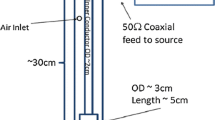Abstract
An acidic precipitation delivery system is described that was designed and constructed for use in a field investigation of the response of red spruce saplings (Picea rubens Sarg.) to the interactive stresses of ozone and acid rain. The system utilizes hydraulic, solid-cone spray nozzles to produce simulated rainfall with droplet size distributions approximating natural rain events, which are of low intensity, i.e., about 1–1.5 cm hr−1, and are relatively uniform in distribution of volume over a 2.4 m diameter plot. Three different pH treatments (3.1, 4.1, 5.1) were dispensed randomly to each of three treatment subplots located in twelve open-top field chambers and three ambient control chambers. Storage capacity of the system permitted a 2.3 hr rain event. Construction materials used were chosen for resistance to the corrosive nature of the rain simulant, stability to ambient UV radiation, and resistance to penetration by sunlight. Simulated events were not synchronized to ambient events, but were scheduled to prevent moisture deficits.
Similar content being viewed by others
References
Blanchard DC (1955) Discussion of raindrop distributions made during Project Shower, Hawaii, 1954. In: Weickmann H (ed) Artificial simulation of rain. Pergamon Press, New York, pp 213–223
Chevone BI, Yang YS, Winner WE, Storks-Cotter I, Long SJ (1984) A rainfall simulator for laboratory use in acidic precipitation studies. J Air Pollut Control Assoc 34:355–359
Geohring LD (1976) Optimization of trickle irrigation design. MS Thesis, Colorado State University, Ft. Collins, 90 pp
Heck WW (1967) Factor influencing expression of oxidant damage to plants. Annual Review of Phytopathology 6:165–188
Hogsett WE, Olszyk D, Ormrod DP, Taylor GE, Tingey DT (1987) Air pollution exposure systems and experimental protocols. Vol 2: Description of facilities. United States Environmental Protection Agency. EPA/600-97/037b. Corvallis, OR, pp C37–40
Jacobson J, Troiano J, Heller L (1986) Stage of development response and recovery of radish plants from episodic exposure and recovery of radish plants from episodic exposure to simulated acidic rain. J Exp Bot 36:159–167
Johnston JW, Shriner DS, Abner CH (1986) Design and performance of an exposure system for measuring the response of crops to acid rain and gaseous pollutants in the field. J Air Pollut Control Assoc 36:894–899
Laurence JA, Kohut RJ (1984) Lake Erie generating station grape study, phase I and II. Contract No. GF127.IT123083. Niagara Mohawk Power Company of the New York State Public Service Commission, Albany, 138 pp
Laurence JA, Kohut RJ, Amundson RG (1989) Response of red spruce seedlings exposed to ozone and simulated acidic precipitation in the field. Arch Environ Contam Toxicol 18:285–290
Lauver TL, McCune DC (1983) Kinetics of removal of particulate deposits from foliage by precipitation. In: Proc of the Second New York State Symposium on Atmospheric Deposition, Albany, NY. 26–27 October. Center for Environmental Research, Cornell University, Ithaca, NY, pp 83–89
Lauver TL, Mandl RH, Kohut RJ, Laurence JA (1989) A weighing lysimeter for determining water loss in red spruce saplings. (In preparation)
Laws JO, Parsons DA (1943) The relation of raindrop size to intensity. Trans Amer Geophys Union 24:452–460
Mandl RH, Kohut RJ, Laurence JA (1988) An integrated system for evaluating the effects of ozone and acidic precipitation on the nutrition, growth, and physiology of red spruce and sugar maple. Environ Pollut 53:444–447
Shriner DS, Abner CH, Mann LK (1977) Rainfall simulation for environmental application. ORNL Publication No. 5151, 17 pp
Stainer RD, Stow CD (1976) Direct methods for the measurement of small water drops. New Zealand J Sci 19:135–143
Takemoto BK, Shriner DS, Johnston JW (1987) Physiological responses of soybean (Glycine max L. Merr.) to simulated acid rain and ambient ozone in the field. Water Air Soil Pollut 33:373–384
Temple PJ, Taylor OL, Benoit LF (1985) Cotton yield response to ozone as mediated by soil moisture and evapotranspiration. J Environ Qual 14:55–60
Tingey DT, Hogsett WE (1985) Water stress reduces ozone injury via a stomatal mechanism. Plant Physiol 77:944–947
Troiano J, Heller L, Jacobson J (1982) Effect of added water and acidity of simulated rain on growth of field-grown radish. Environ Pollut (Ser. A) 29:1–11
Troiano J, Jacobson J, Heller L (1985) Effects of simulated acidic rain applied alone and in combination with ambient rain on growth and yield of field-grown snapbean. Agric Ecosyst Environ 11:161–172
Vennard JK (1961) Fluid Dynamics, 4th edn. John Wiley and Sons, New York, 303 pp
Wiesner CJ (1970) Hydrometeorology. Chapman and Hall Ltd, London, 232 pp
Author information
Authors and Affiliations
Rights and permissions
About this article
Cite this article
Lauver, T.L., Laurence, J.A. & Kohut, R.J. Design and performance of an acidic precipitation delivery system for field investigations with plants. Arch. Environ. Contam. Toxicol. 19, 629–634 (1990). https://doi.org/10.1007/BF01183976
Received:
Revised:
Issue Date:
DOI: https://doi.org/10.1007/BF01183976




